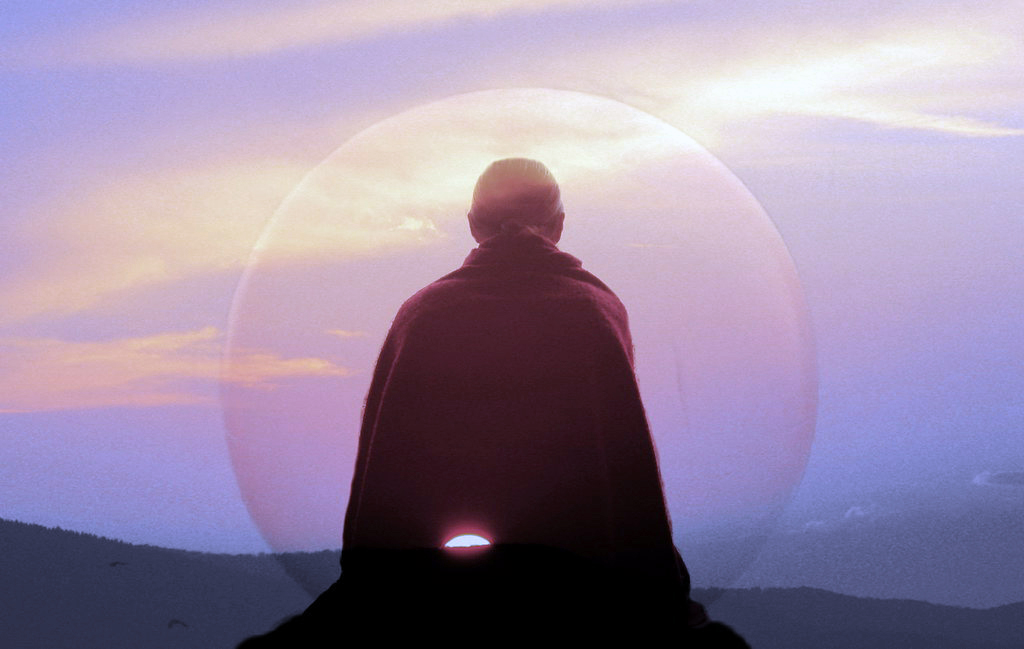Let’s zoom in on mindfulness to get a sense of what we’re after when we sit down to meditate.
Mindful.org says it’s “the basic human ability to be fully present, aware of where we are and what we’re doing, and not overly reactive or overwhelmed by what’s going on around us.”
There are a few interesting things here.
Mindfulness is a “basic” human ability. Meaning, it’s not some complex skill that we have to spend 10,000 hours learning how to do. It’s available to us in any moment.
You can think of the ability to stay in the present moment as like the sun. It’s always there. There are clouds in the way sometimes, sure. But the sun is still there in the background.
We can’t push the clouds away. We must accept that they’re there and wait for them to pass. Same thing with a big storm — some big trauma or emotional state. No matter how shitty it feels, it will pass.
The Buddha — the ancient spiritual master who developed mindfulness meditation — stumbled on mindfulness when he was a young boy.
His family was watching the ritual first plowing of the fields. As the sun scorched, he sat in the shade of a rose-apple tree.
Plows turned up the soil exposing worms that wriggled around trying to find cover. Other worms writhed in pain after being cut in half. Birds hovered near the ground to eat the defenseless worms and other bugs that laid bare for their easy picking. A hawk swooped down and caught one of the small birds.
The Buddha felt the striving of the man plowing. He felt the exhaustion of the water buffalo chained to the plow. He felt the pain of the worms cut by the plow and the small bird taken by the hawk. He felt the unpredictability of life itself.
That’s what we’re doing when we meditate. We’re getting out of our head and into our bodies. We’re feeling rather than thinking. We’re connecting rather than staying disconnected, caught up in the little drama in our head.
It’s like that old Zen Buddhist story about two monks watching a flag flapping in the wind. One said to the other, “The flag is moving.” The other replied, “The wind is moving.”
Another monk overheard this and said, “Not the flag, not the wind. Mind is moving.”
When we’re caught up in the drama, we’re not seeing the big picture. We’re missing the fact that everything is changing and moving and living and dying all of the time.
The other interesting part of the definition is about reactivity.
When we’re practicing mindfulness, we’re cultivating equanimity. Meaning, while we might feel things — even painful, difficult things — we’re not overwhelmed by them.
We can be with our feelings without necessarily acting on them. Which also means we can be with others’ feelings without necessarily having to do anything.
We have a little more choice. We can respond rather than react.
Say a woman cuts the line in front of you at the grocery store. You might get angry because you’re in a rush. You might yell or say something passive aggressive or stew about it for the rest of the night.
But, as the late author David Foster Wallace said in his commencement speech “This is Water”:
Maybe she’s not usually like this. Maybe she’s been up three straight nights holding the hand of a husband who is dying of bone cancer. Or maybe this very lady is the low-wage clerk at the motor vehicle department, who just yesterday helped your spouse resolve a horrific, infuriating, red-tape problem through some small act of bureaucratic kindness.
Of course, none of this is likely, but it’s also not impossible. It just depends what you want to consider. If you’re automatically sure that you know what reality is, and you are operating on your default setting, then you, like me, probably won’t consider possibilities that aren’t annoying and miserable.
But if you really learn how to pay attention, then you will know there are other options. It will actually be within your power to experience a crowded, hot, slow, consumer-hell type situation as not only meaningful, but sacred, on fire with the same force that made the stars: love, fellowship, the mystical oneness of all things deep down.
In other words, mindfulness is about remembering that everything is connected, despite our mind’s attempts to say otherwise.
Hi, I’m Jeremy, a writer, meditation teacher, and host of the Meditation for the 99% podcast. I’m here to help you be more mindful about work, relationships, and politics. Subscribe to my weekly email here.
Download my free ebook on how meditation can transform your life.
Photo by Hartwig HKD.
